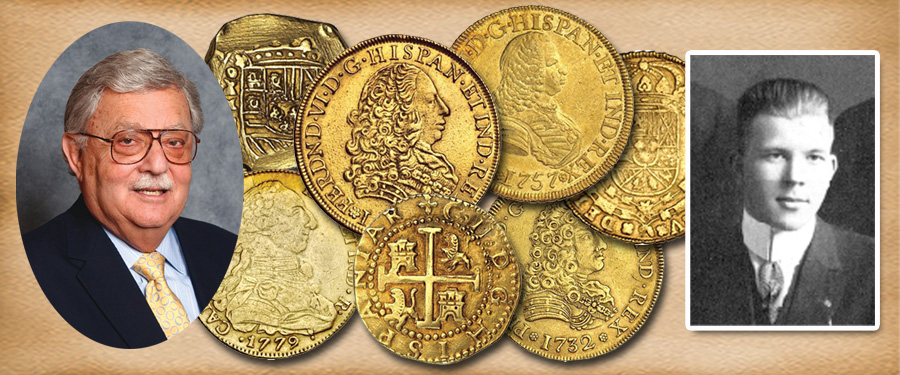
As
I explained in an earlier part of this story, Stack’s involvement with the
Josiah K. Lilly Collection all started with his initial visit to Stack’s in New
York. As related he and his wife traveled to Florida each winter by train, stopping off in New York on their way South in the fall and again on their way back in
the spring.
He instructed us on these visits to keep searching
for doubloons, as well as other coins from the English, French,
Portuguese and Italian series we had already started. We concentrated on the Spanish
Colonial series, contacting dealers and collectors all over to find and set aside
more of these coins. We also continued to seek other European coinage as Mr.
Lilly requested.
On his visit in the spring of 1953 we were able to
show him what we had assembled. With the addition of this group his collection
of doubloons would be close to 200 different
pieces. He liked what we had done, and asked that we bring them to Indianapolis
within a few
weeks, which of course we did.
He then expressed interest in another collecting
area: the gold coins of the United States. We explained that we had built collections for many others. He learned that
in 1943 Stack’s had bought all the half eagles, ($5 gold) 1795 to 1929, and eagles
($10 gold) 1795 to 1933, from the Col. E.H.R. Green Collection. Included
were hundreds of duplicates, especially in the early issues, before the coin sizes
were reduced.
The first sets of $5 and $10 gold we sold to King
Farouk of Egypt, through his personal representative. These were sent by
diplomatic pouch to Cairo. The second set,
almost as complete as the first, we sold to an American client, Clifford T .
Weihman. The balance of the dates and duplicates were put into our inventory.
Even after we sold the two sets, it was still the largest stock of early
coinage in any dealer’s inventory. We showed Mr. Lilly examples and he said
he would think about it.
As he had started collecting with the largest gold
Spanish-American coins, he felt he should start with the largest coin of the
United States, the $20 gold double eagle. Mr. Lilly
asked, "How many different are there?" We told him there were 199. He
replied that it would take some time to assemble that many pieces. We told him
about a collector in Texas who might consider selling his set of $20 gold coins. He
expressed his interest and suggested we inquire about it and if possible
let him know
on his return to New York in the fall. After he left for Indianapolis we
started our pursuit of double eagles.
In early May I again traveled with my father,
Morton, to Indianapolis, following the established system and delivered what we
had acquired over the previous winter.
At Eagle’s Nest, Mr. Lilly showed us again his growing collection of lead
soldiers. Each group had five to seven soldiers lined up, showing the foot
soldier, the flag bearer, the drummer, the officer in charge, and sometimes
the general. Each was accurately fashioned into the proper uniform of that division,
each with the appropriate hat, the proper sashes and epaulets in place, the
correct color for a dress parade. He had over 4,500 soldiers, ranging from
the Green Mountain Boys, to Colonial soldiers, to post-Revolution federal troops, through
the decades
before the Civil War. There were examples wearing the various uniforms of the
Blue and the Grey and (which were often
different as each regiment had its own designs and hats, yet basically in the
colors of the North or South) continuing to the First World War. It was a view of history,
in miniature. These lead soldiers were amazing when you saw them all displayed
before you. Mr. Lilly had employed the finest maker of lead soldiers, who
resided in Philadelphia to make and complete his collection. Dedicated collector
that he was, Mr. Lilly personally researched the appropriate uniforms for each
regiment he portrayed. As with all his hobbies, he researched them carefully,
and engaged only qualified experts to guide him.
See you next week.





